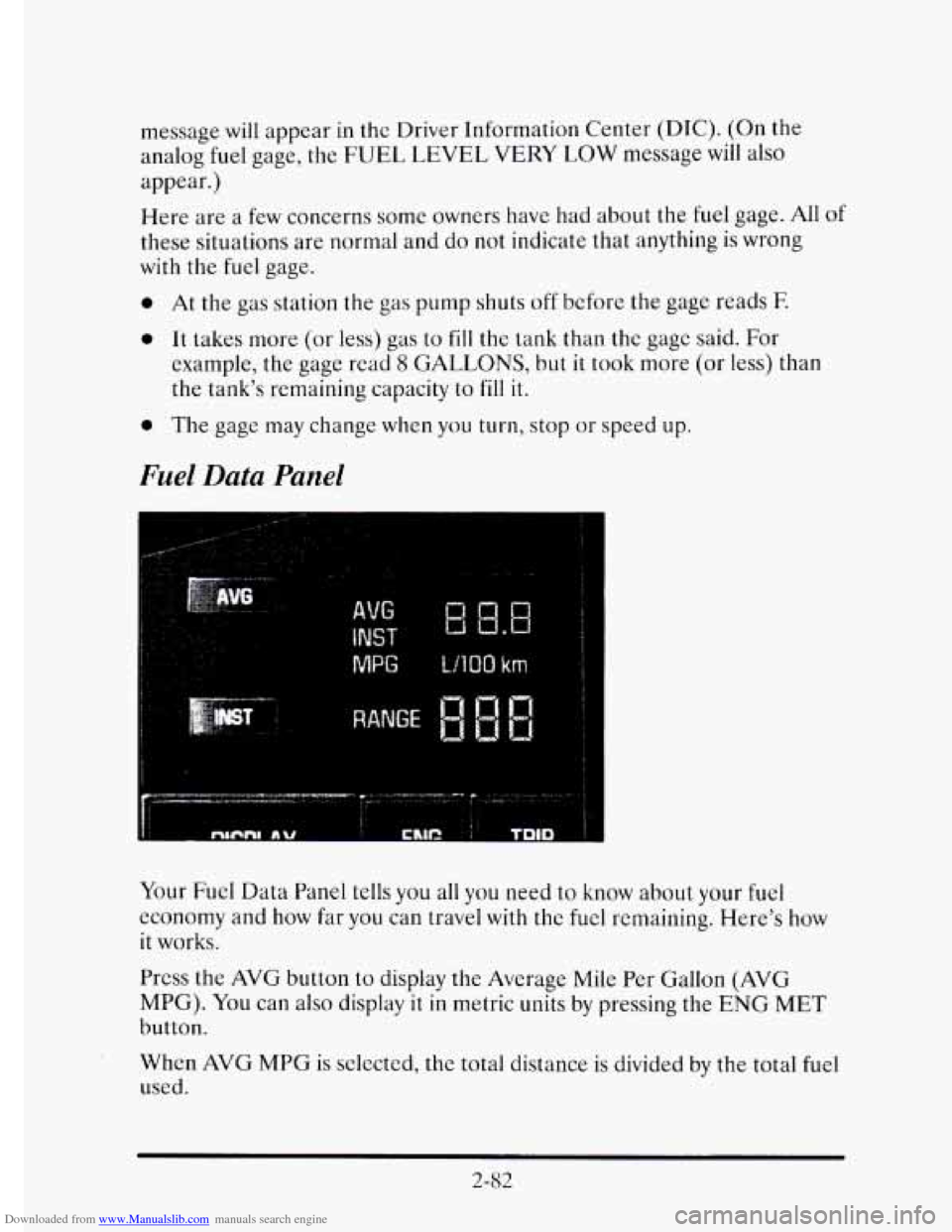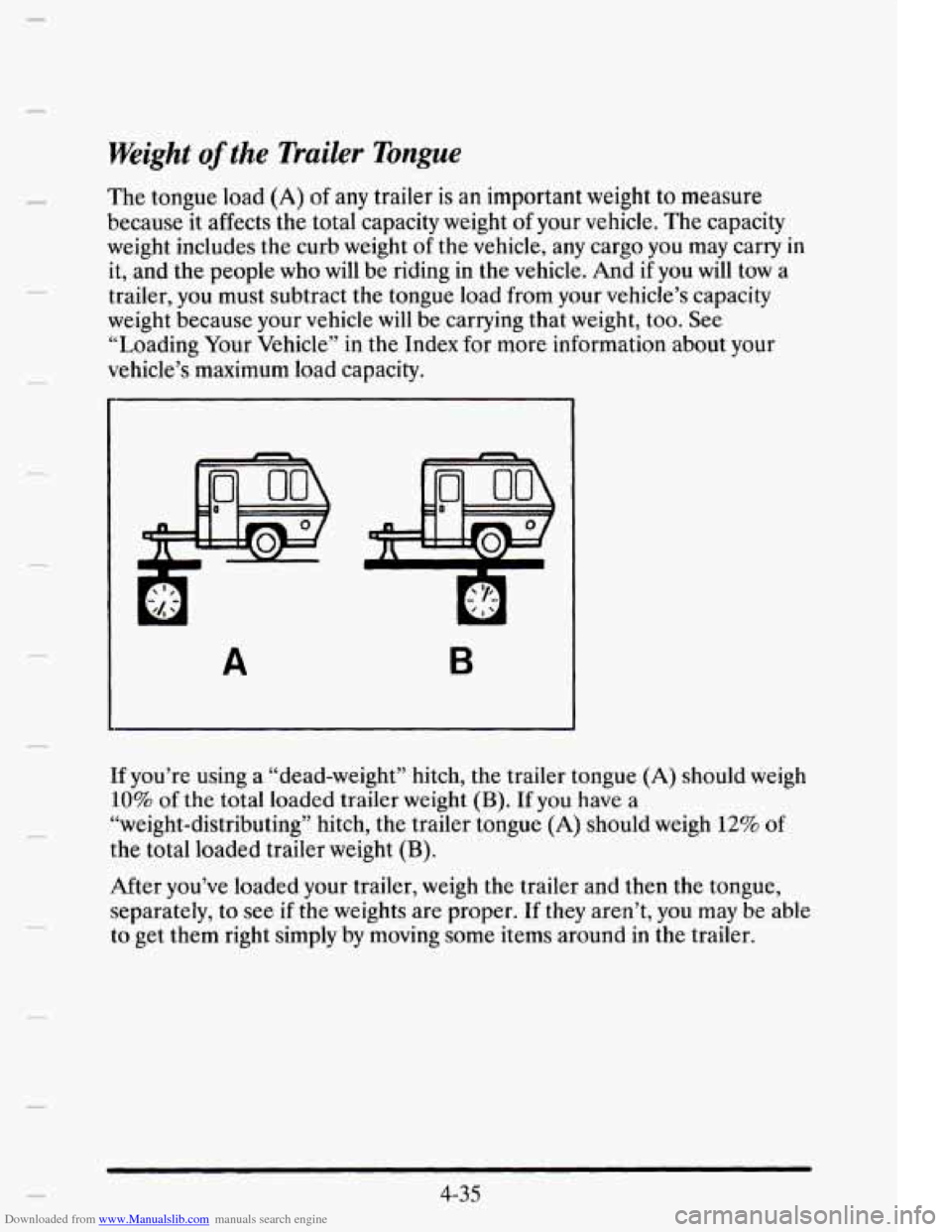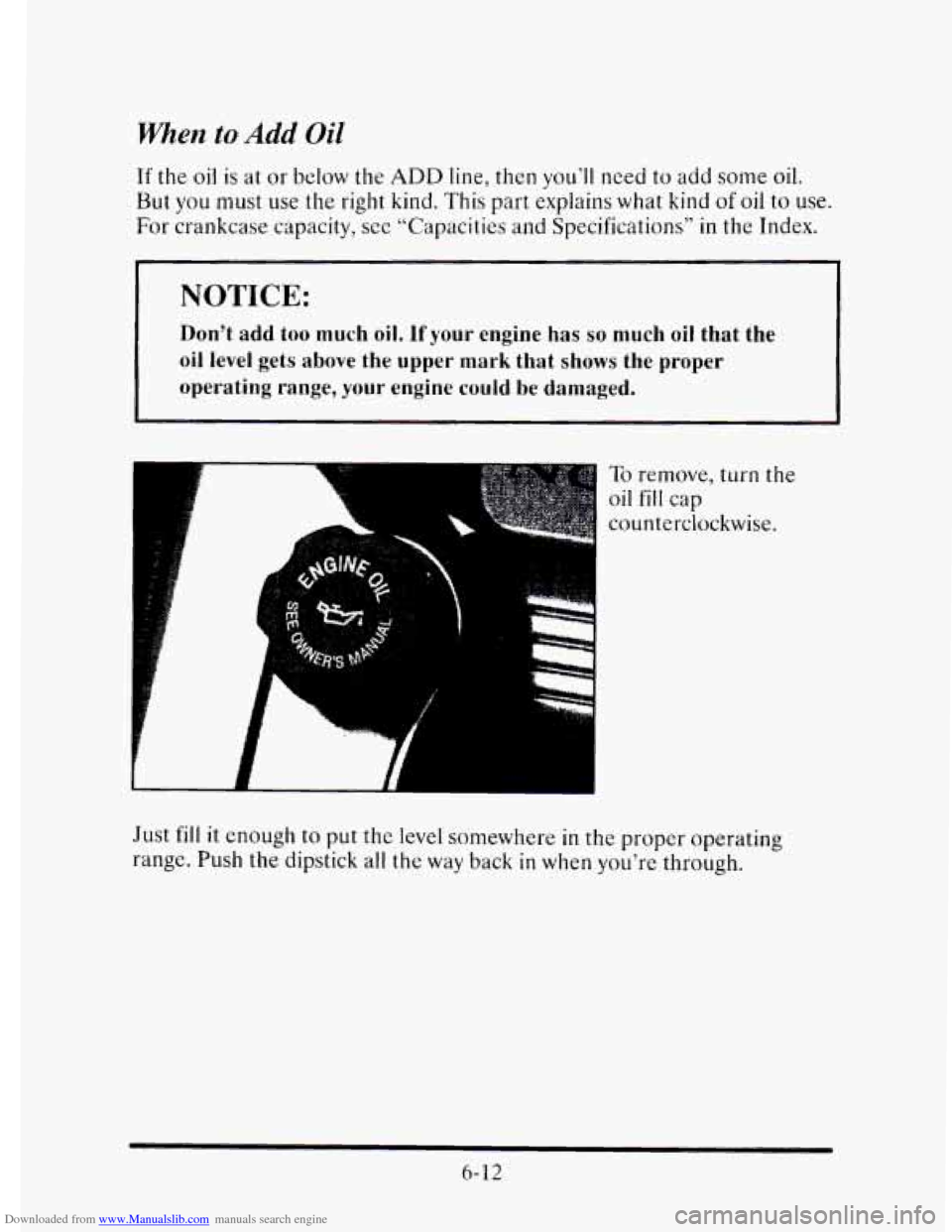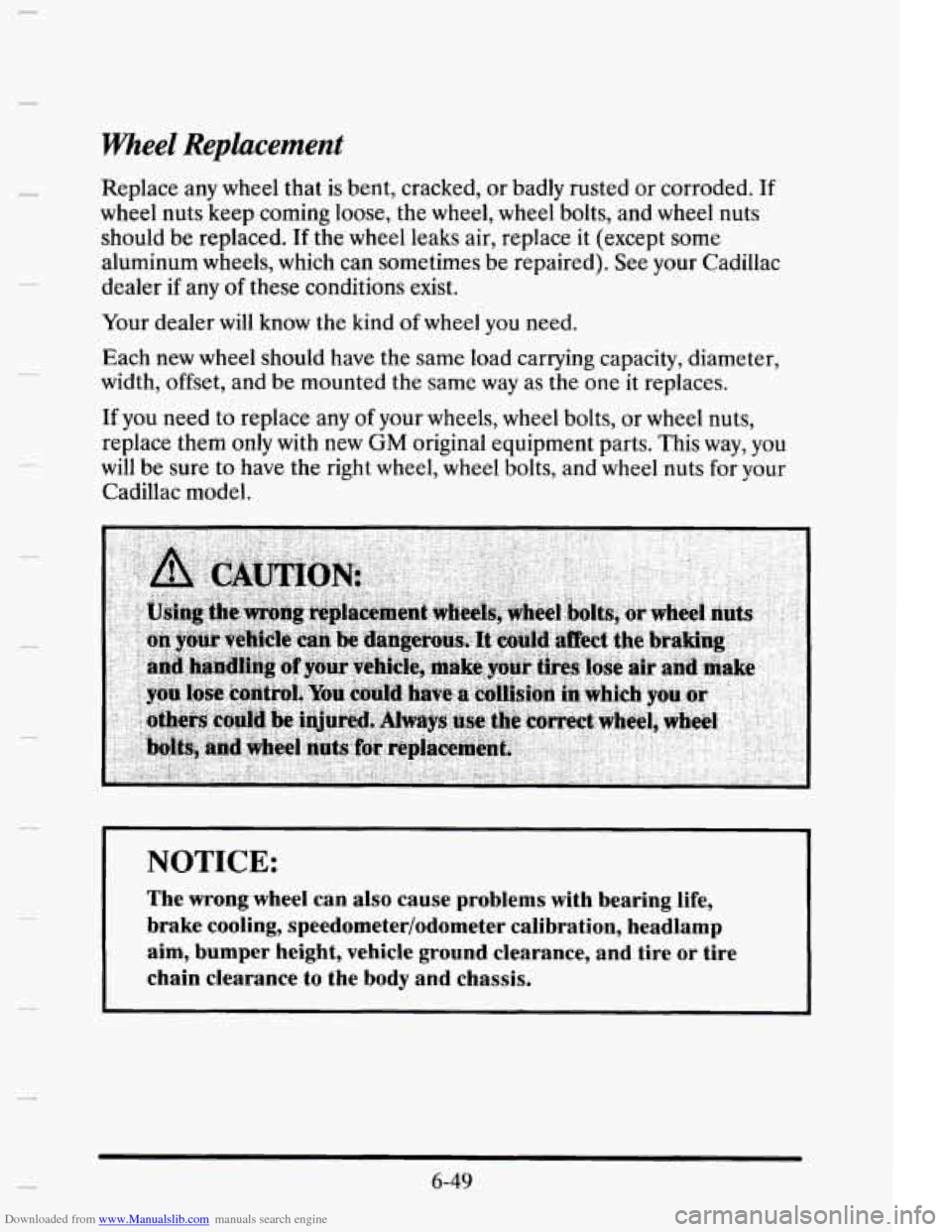1995 CADILLAC ELDORADO load capacity
[x] Cancel search: load capacityPage 153 of 395

Downloaded from www.Manualslib.com manuals search engine message will appear in the Driver Information Center (DIC). (On the
analog
fuel gage, the FUEL LEVEL VERY LOW message will also
appear.)
Here are a
few concerns some owners have had about the fuel gage. All of
these situations are normal and do not indicate that anything is wrong
with the fuel gage.
0 At the gas station the gas pump shuts off before the gage reads F.
0 It takes more (or less) gas to fill the tank than the gage said. For
example, the gage read
8 GALLONS, but it took more (or less) than
the tank's remaining capacity
to fill it.
0 The gage may change when you turn, stop or speed up.
Fuel Data Panel
Your Fuel Data Panel tells you all you need to know about your fuel
economy and how far you can travel with the fuel remaining. Here's how
it works.
Press the AVG button to display the Average Mile Per Gallon (AVG
MPG).
You can also display it in metric units by pressing the ENG MET
button.
When AVG MPG is sclected, the total distance
is divided by the total fuel
used.
2-82
Page 217 of 395

Downloaded from www.Manualslib.com manuals search engine Preserve the fuel as long as you can. To help keep warm, you can get out
of the vehicle and do some fairly vigorous exercises every half hour or
SO
until help comes.
LOmING YOUR VEHICLE
~~
( TIRE-LOADING INFORMATION
OCCUPANTS VEHICLE CAP.
WT.
FRT. CTR. RR. TOTAL LBS. KG
MAX. LOADING
& GVWR SAME AS VEHICLE
CAPACITY WEIGHT XXX
COLD TIRE
TIRE SIZE SPEED PRESSURE
RTG PSVKPa
F
RT.
RR.
SPA.
IF TIRES ARE HOT. ADD 4PSV28KPa SEE
OWNER’S MANUAL FOR ADDITIONAL
INFORMATION
-_ - - - GEN GME,
Two labels on your vehicle show how much weight it may properly carry.
The Tire-Loading Information label found
on the driver’s door tells you
the proper size, speed rating and recommended inflation pressures for the
tires
on your vehicle. It also gives you important information about the
number
of peoplc that can be in your vehicle and the total weight that you
can carry. This weight
is called the Vehicle Capacity Weight and includes
the weight
of all occupants, cargo, and all options not installed in the
factory.
4-30
Page 218 of 395

Downloaded from www.Manualslib.com manuals search engine MfD BY GENERAL MOTORS CORP
DATE GVWR GAWR FRT GAWR RR
THIS VEHICLE CONFORMS TO ALL APPLI-
CABLE U.S. FEDERAL
MOTOR VEHICLE
TION STANDARDS
IN EFFECT ON THE
DATE OF MANUFACTURE SHOWN ABOVE.
SAFETY, BUMPER, AND THEFT
PREVEN-
GEN GME 1
The other label is the Certification label, found on the rear edge of the
driver’s door. It tells you
the gross weight capacity of your vehicle, called
the GVWR (Gross Vehicle Weight Rating). The GVWR includes the
weight
of the vehicle, all occupants, fuel and cargo. Never exceed the
GVWR for your vehicle, or the Gross
Axle Weight Rating (GAWR) for
either the front or rear axle.
If you do have a heavy load, you should spread
it out. Don’t carry more
than
176 pounds (80 kg) in your trunk.
If you put things inside your vehicle
-- like suitcases, tools, packages, or
anything else
-- they will go as fast as the vehicle goes. If you have to stop
or turn quickly, or
if there is a crash, they’ll keep going.
4-3 1
Page 220 of 395

Downloaded from www.Manualslib.com manuals search engine NOTICE:
Pulling a trailer improperly can damage your vehicle and result
in costly repairs not covered by your warranty. To pull a trailer
correctly, follow the advice in this part, and see your Cadillac
dealer for important information about towing a trailer with
your vehicle.
Your vehicle can tow a trailer if it is equipped with the Northstar 4.6L
engine and proper trailer towing equipment. To identify what the vehicle
trailering capacity
is for your vehicle, you should read the information in
“Weight of the Trailer” that appears later in this section. But trailering is
different than just driving your vehicle by itself. Trailering means changes
in handling, durability, and fuel economy. Successful, safe trailering takes
correct equipment, and it has to be used properly.
That’s the reason for this part. In it are many time-tested, important
trailering tips and safety rules. Many
of these are important for your
safety and that
of your passengers. So please read this section carefully
before you pull
a trailer.
Load-pulling components such as the engine, transaxle, wheel assemblies,
and tires are forced to work harder against the drag
of the added weight.
The engine is required
to operate at relatively higher speeds and under
greater loads, generating extra heat. What’s more, the trailer adds
considerably
to wind resistance, increasing the pulling requirements.
If You Do Decide To Pull A nailer
If you do, here are some important points.
e There are many different laws, including speed limit restrictions,
having to do with trailering. Make sure your rig will
be legal, not only
where you live but
also where you’ll be driving. A good source for this
information can be state or provincial police.
Consider using a sway control.
4-33
Page 222 of 395

Downloaded from www.Manualslib.com manuals search engine n
Weight of the Trailer Tongue
The tongue load (A) of any trailer is an important weight to measure
because it affects the total capacity weight
of your vehicle. The capacity
weight includes
the curb weight of the vehicle, any cargo you may carry in
it, and the people
who will be riding in the vehicle. And if you will tow a
trailer, you must subtract the tongue load from your vehicle’s capacity
weight because your vehicle will be carrying that weight,
too. See
“Loading Your Vehicle”
in the Index for more information about your
A
vehicle’smaximum load capacity.
If you’re using a “dead-weight” hitch, the trailer tongue (A) should weigh
:LO% of the total loaded trailer weight (B). If you have a
“weight-distributing” hitch, the trailer tongue (A) should weigh
12% of
the total loaded trailer weight (B).
After you’ve loaded your trailer, weigh the trailer and then the tongue,
separately, to
see if the weights are proper. If they aren’t, you may be able
to get them right simply by moving some items around in the trailer.
4-35
Page 271 of 395

Downloaded from www.Manualslib.com manuals search engine When to Add Oil
If the oil is at or below the ADD line, then you’ll need to add some oil.
But you must use the right kind. This part explains what kind of oil to use.
For crankcase capacity, see “Capacities and Specifications” in the Index.
NOTICE:
Don’t add too much oil. If your engine has so much oil that the
oil level gets above the upper mark that shows the proper
operating range, your engine could be damaged.
To remove, turn the
oil fill cap
counterclockwise.
Just
fill it enough to put the level somewhere in the propcr operating
rangc. Push
the dipstick all the way back in when you’re through.
6-12
Page 308 of 395

Downloaded from www.Manualslib.com manuals search engine Wheel Replacement
Replace any wheel that is bent, cracked, or badly rusted or corroded. If
wheel nuts keep coming loose, the wheel, wheel bolts, and wheel nuts
should be replaced. If the wheel leaks air, replace
it (except some
aluminum wheels, which can sometimes be repaired). See your Cadillac
dealer
if any of these conditions exist.
Your dealer will know the kind of wheel you need.
Each new
wheel should have the same load carrying capacity, diameter,
width,
offset, and be mounted the same way as the one it replaces.
If you need to replace any of your wheels, wheel bolts, or wheel nuts,
replace them
only with new GM original equipment parts. This way, you
will be sure to have the right wheel, wheel bolts, and wheel nuts for your
Cadillac model.
NOTICE:
The wrong wheel can also cause problems with bearing life,
brake cooling, speedometer/odometer calibration, headlamp aim, bumper height, vehicle ground clearance, and tire or tire \
chain clearance
to the body and chassis.
6-49